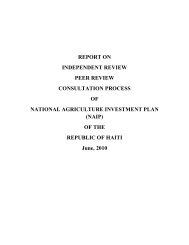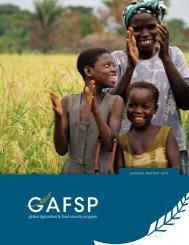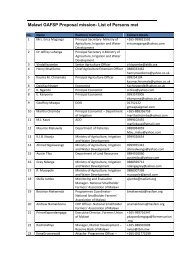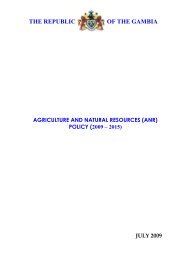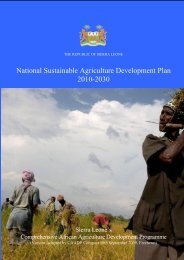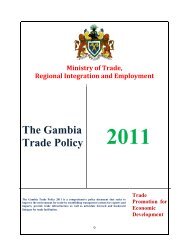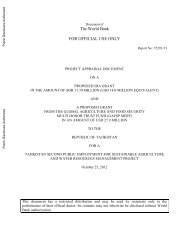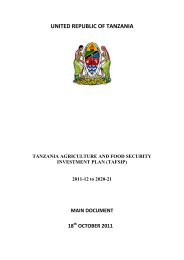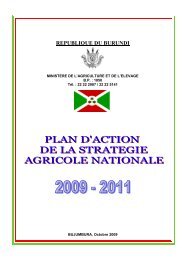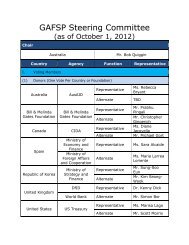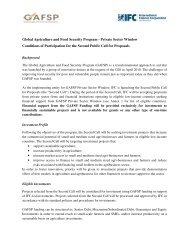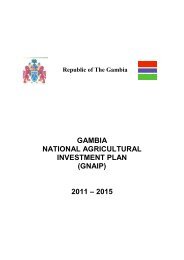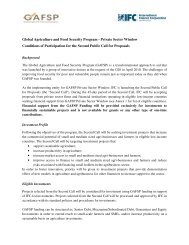Haiti: Poverty Reduction Strategy Paper; IMF Country Report 08/115 ...
Haiti: Poverty Reduction Strategy Paper; IMF Country Report 08/115 ...
Haiti: Poverty Reduction Strategy Paper; IMF Country Report 08/115 ...
Create successful ePaper yourself
Turn your PDF publications into a flip-book with our unique Google optimized e-Paper software.
1 The Context<br />
INTRODUCTION<br />
1 Over the past twenty years, <strong>Haiti</strong> has undergone profound change that has affected all important<br />
aspects of national life, particularly in the political, economic, social, and environmental spheres.<br />
These changes have taken place in a global context affected by the sudden and multifaceted<br />
impact of rapid demographic growth resulting from a sequence of events, in particular: i/ the<br />
failure to manage the effects of the 1980-1982 international economic crisis, ii/ internal political<br />
instability resulting from the collapse of the political regime, iii/ the dramatic process of<br />
liberalization that started in 1987 and, iv/ the 1991-1994 trade embargo imposed by the<br />
international community.<br />
2 As a result of this multidimensional and protracted crisis, <strong>Haiti</strong> has been rapidly and greatly<br />
surpassed by the majority of small Latin American and Caribbean economies, so much so that<br />
currently, it is the only LDC in the Western Hemisphere. At the same time, a process of<br />
widespread impoverishment has gradually taken hold. This strong and adverse trend is fueled<br />
largely by economic decline that is impacting all economic subsectors that were in a growth<br />
phase during the 1970s, such as the manufacturing, tourism, agro-industry, and agricultural export<br />
industries. The decline has also been reflected in a simultaneous process of decapitalization of<br />
the other branches of the rural economy. Now that political stability has been restored, while the<br />
establishment of a macroeconomic framework and modest but sustained economic growth over<br />
the past four years represent significant strides, they fall short of meeting the legitimate<br />
aspirations of the <strong>Haiti</strong>an people for a better life.<br />
3 The drafting of the Growth and <strong>Poverty</strong> <strong>Reduction</strong> <strong>Strategy</strong> <strong>Paper</strong> (DSNCRP) reflects the desire<br />
of the <strong>Haiti</strong>an Government to respond appropriately to the aspirations of the <strong>Haiti</strong>an people and to<br />
the major growth and poverty reduction challenges. The DSNCRP is therefore a follow up, first,<br />
to the Interim Cooperation Framework (ICF) prepared with the help of the International<br />
Community in 2004, second, to the strategy targeting the major work areas [Grands Chantiers]<br />
submitted by the Government to the International Conference on Economic and Social<br />
Development in <strong>Haiti</strong> held in Port-au-Prince on July 25, 2006, and third, to the Interim <strong>Poverty</strong><br />
<strong>Reduction</strong> Growth and <strong>Poverty</strong> <strong>Reduction</strong> <strong>Strategy</strong> <strong>Paper</strong> of September, 2006. The drafting has<br />
benefited from a long participatory process involving the principal state and non-state actors,<br />
ensuring its ownership by the entire population.<br />
2 The Participatory Process<br />
4 The participatory process was identified on the basis of previous experience with <strong>Haiti</strong>, lessons<br />
learned, and recommendations made at information/training workshops held during the I-PRSP<br />
drafting process in 2005. It was conducted through a series of meetings, gatherings, seminars,<br />
workshops, and forums held at all levels (sectoral, local, departmental, and national) with the aim<br />
of ensuring the broadest possible participation of the various partners.<br />
5 These partners, particularly the poor themselves, include vulnerable groups; organized civil<br />
society groups: the press, trade unions, cooperative entities, professional associations, chambers<br />
of commerce and industry, human rights organizations, women, young people, etc.; the formal<br />
and informal business sectors; central, deconcentrated, and decentralized state administrations;<br />
autonomous state institutions; universities; NGOs; members of parliament; locally-elected<br />
officials (Mayors and CASEC [Conseil d'administration de section communal], grassroots<br />
organizations and/or associations, aid or multilateral and bilateral cooperation agencies, etc.<br />
14



